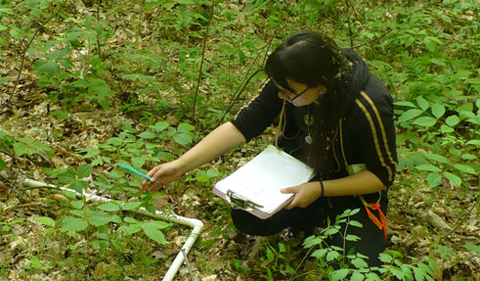
Marion Holmes
By Heather Willard
PACE Writer Environmental & Plant Biology
The Ecological Society of America is the largest organization of professional ecologists in the nation, and when they gathered this summer in Ft. Lauderdale, FL, three Ohio University scientists joined them: Dr. David Rosenthal, Dr. Glenn Matlack, and Ph.D. candidate Marion Holmes.
Rosenthal presented a poster on the photosynthesis model he is using to determine how climate change will affect the hybrid American and Chinese Chestnut. He first received the hybrid seeds from the American Chestnut Foundation, who are working to restore the eastern woodlands of America after a blight extirpated the American Chestnut. “The long-term goal is to see how much more carbon uptake they’ll have in coordination with climate change,” he said.
Matlack and Holmes have been working together on a study of the forests and old fields in the eastern United States after the soil structure was altered through agriculture several decades ago. Matlack has been working on the accumulation of trees, while Holmes has been working on the accumulation of wildflowers.
Matlack says that originally they assumed that the sites where trees started would be vastly different, but that was the exact opposite of what they saw. “Just because of random colonization events in the stands early on, they were very different. But with time, all species came to all the sites,” he said.
Matlack also found that the growth phase of the trees was interesting. “There’s a phase right at the beginning where the seedlings viciously compete, and then nothing happens for 50 to 60 years, the trees just grow. And after that there is a second episode where the trees start dying,” he explained.
Holmes presented her research on how forest species come back after disturbance, particularly agriculture disturbance. A lot of the forests around Athens are relatively young, and have come back after a large amount of subsistence farming shifted to locations further west. She was looking specifically at wildflowers and herbaceous species, which she says are underappreciated.
She found that species came back faster in previously pastureland than in formerly cultivated crops. “There were a lot of good questions after (my presentation),” Holmes said. “I met a lot of people, some of whom were interested in potentially collaborating in the future.”



















Comments